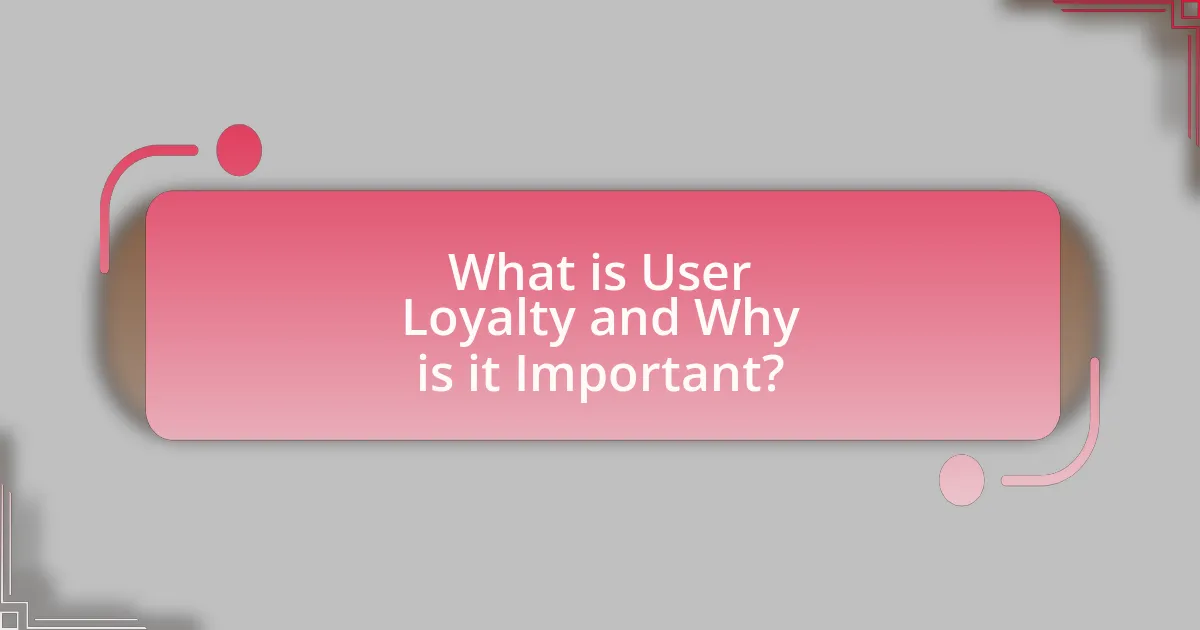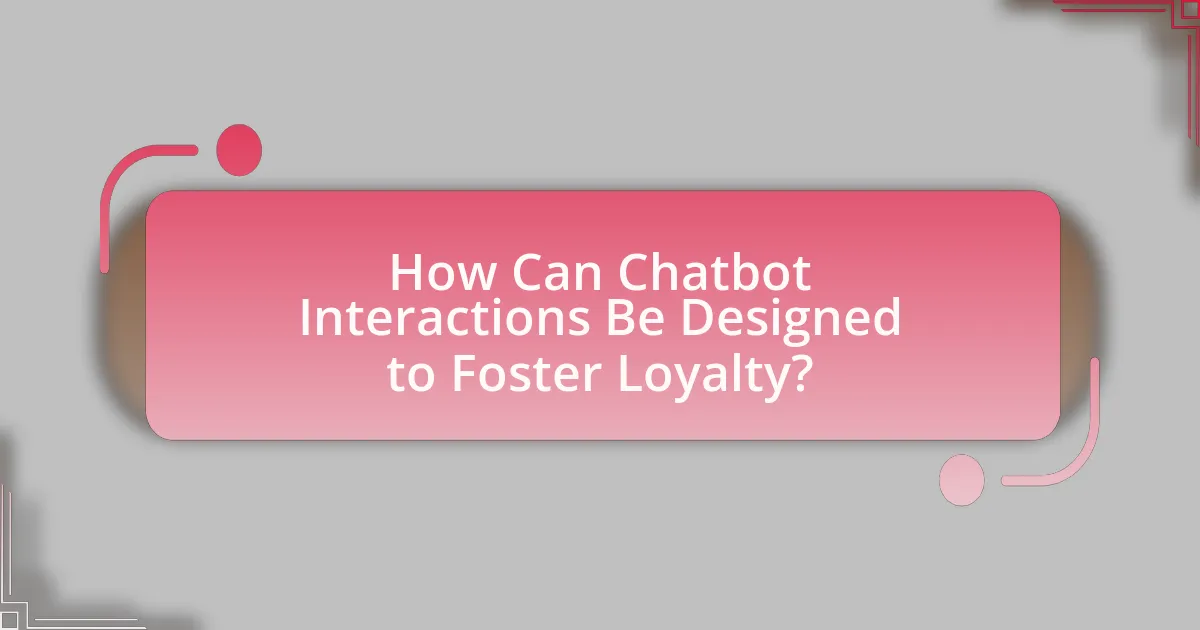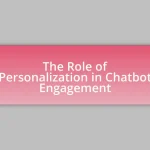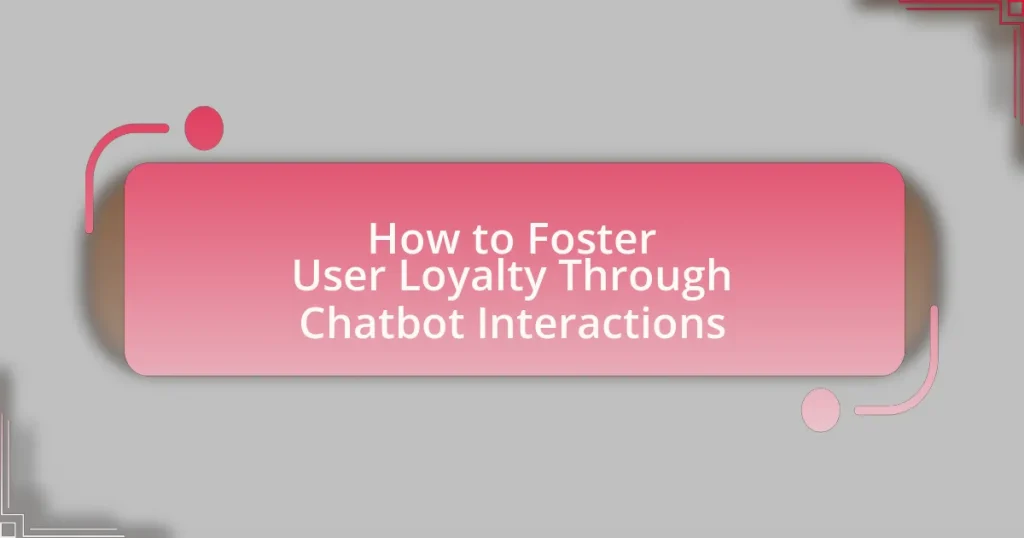User loyalty refers to the commitment of customers to repeatedly choose a brand or service over competitors, significantly impacting a company’s profitability and reputation. This article explores the definition of user loyalty in digital interactions, the characteristics of loyal users, and the financial benefits of retaining customers. It emphasizes the role of chatbots in fostering user loyalty through personalized support, quick responses, and tailored interactions. Additionally, it outlines best practices for chatbot design, the importance of measuring user satisfaction and retention, and strategies for continuous improvement to enhance user loyalty.

What is User Loyalty and Why is it Important?
User loyalty is the commitment of customers to consistently choose a brand or service over competitors. This loyalty is crucial because it leads to repeat purchases, reduces marketing costs, and fosters positive word-of-mouth, which can significantly enhance a company’s reputation and customer base. Research indicates that increasing customer retention by just 5% can boost profits by 25% to 95%, highlighting the financial benefits of cultivating user loyalty.
How do we define user loyalty in the context of digital interactions?
User loyalty in the context of digital interactions is defined as the ongoing commitment of users to engage with a brand or service consistently over time. This loyalty is often demonstrated through repeated interactions, positive user experiences, and a preference for a specific brand over competitors. Research indicates that 74% of consumers are likely to switch brands if they find the purchasing process too difficult, highlighting the importance of seamless digital interactions in fostering loyalty.
What are the key characteristics of loyal users?
Loyal users exhibit several key characteristics, including consistent engagement, emotional connection, and advocacy for the brand. Consistent engagement is demonstrated through regular interactions with the product or service, indicating a strong preference and reliance on it. Emotional connection arises when users feel a sense of belonging or attachment to the brand, often influenced by positive experiences and personalized interactions. Advocacy is evident when loyal users actively promote the brand to others, showcasing their trust and satisfaction. Research indicates that emotionally connected customers are 52% more valuable than those who are just satisfied, highlighting the importance of fostering these characteristics in user loyalty strategies.
Why does user loyalty matter for businesses?
User loyalty matters for businesses because it directly impacts profitability and long-term success. Loyal customers tend to make repeat purchases, which can lead to increased revenue; studies show that acquiring a new customer can cost five times more than retaining an existing one. Additionally, loyal customers are more likely to recommend the business to others, enhancing brand reputation and attracting new clients. According to research by Bain & Company, a 5% increase in customer retention can lead to a 25% to 95% increase in profits, underscoring the financial benefits of fostering user loyalty.
What role do chatbots play in fostering user loyalty?
Chatbots play a crucial role in fostering user loyalty by providing instant, personalized support and enhancing user engagement. Their ability to deliver 24/7 assistance ensures that users receive timely responses to inquiries, which significantly improves customer satisfaction. According to a study by HubSpot, 90% of users report that an immediate response is important when they have a question, highlighting the importance of chatbots in meeting user expectations. Furthermore, chatbots can analyze user behavior and preferences, allowing for tailored interactions that resonate with individual users, thereby strengthening their connection to the brand. This personalized approach not only increases user retention but also encourages repeat interactions, ultimately fostering long-term loyalty.
How can chatbots enhance user experience?
Chatbots enhance user experience by providing instant responses and personalized interactions. They can handle multiple inquiries simultaneously, reducing wait times and improving accessibility. According to a study by IBM, businesses can save up to 30% in customer service costs by implementing chatbots, which allows for more efficient resource allocation. Additionally, chatbots can analyze user data to tailor responses, creating a more engaging and relevant experience for users. This personalization fosters user loyalty, as customers feel understood and valued.
What are the psychological factors that chatbots can leverage to build loyalty?
Chatbots can leverage psychological factors such as personalization, consistency, and social presence to build user loyalty. Personalization enhances user experience by tailoring interactions based on individual preferences and past behaviors, which has been shown to increase user satisfaction and engagement. Consistency in responses fosters trust, as users feel more secure when they receive reliable information and support. Additionally, social presence, achieved through empathetic language and conversational tone, creates a sense of connection, making users feel valued and understood. Research indicates that these factors significantly influence user retention and loyalty in digital interactions, as evidenced by studies showing that personalized experiences can lead to a 10-15% increase in customer loyalty metrics.

How Can Chatbot Interactions Be Designed to Foster Loyalty?
Chatbot interactions can be designed to foster loyalty by personalizing user experiences and providing timely, relevant responses. Personalization enhances user engagement; for instance, chatbots that remember user preferences and past interactions can create a sense of familiarity and trust. According to a study by Salesforce, 70% of consumers say a company’s understanding of their personal needs influences their loyalty. Additionally, ensuring quick response times and resolving issues efficiently can significantly improve user satisfaction, as 90% of consumers expect an immediate response from chatbots. By combining personalization with efficiency, chatbots can effectively build and maintain user loyalty.
What are the best practices for chatbot design to enhance user engagement?
The best practices for chatbot design to enhance user engagement include providing personalized interactions, ensuring quick response times, and maintaining a user-friendly interface. Personalization increases user satisfaction by tailoring responses based on user data, which studies show can improve engagement rates by up to 50%. Quick response times are crucial, as research indicates that 60% of users expect a response within 5 seconds, and delays can lead to frustration and disengagement. A user-friendly interface, characterized by intuitive navigation and clear prompts, facilitates smoother interactions, thereby increasing the likelihood of user retention and loyalty.
How can personalization in chatbot interactions improve user loyalty?
Personalization in chatbot interactions can significantly improve user loyalty by creating tailored experiences that meet individual user needs and preferences. When chatbots utilize data such as user history, preferences, and behavior, they can provide relevant recommendations and solutions, enhancing user satisfaction. Research indicates that personalized experiences can lead to a 20% increase in customer engagement and a 10% rise in customer retention rates. This demonstrates that users are more likely to remain loyal to brands that recognize and cater to their unique requirements, fostering a deeper emotional connection and trust.
What tone and language should chatbots use to resonate with users?
Chatbots should use a friendly, conversational tone and clear, concise language to resonate with users. This approach fosters a sense of approachability and engagement, making users feel comfortable interacting with the chatbot. Research indicates that a conversational style, which includes using everyday language and a warm tone, enhances user satisfaction and encourages ongoing interactions. For instance, a study by the Nielsen Norman Group found that users prefer chatbots that mimic human-like conversation, leading to higher user retention and loyalty.
How can chatbots provide value to users to encourage loyalty?
Chatbots can provide value to users by delivering personalized experiences, which encourages loyalty. By utilizing data analytics and machine learning, chatbots can tailor interactions based on user preferences and past behaviors, leading to more relevant and engaging conversations. For instance, a study by Salesforce found that 70% of consumers say a company’s understanding of their personal needs influences their loyalty. Additionally, chatbots can offer 24/7 support, ensuring users receive timely assistance, which enhances satisfaction and trust. This consistent availability and personalized service create a strong foundation for user loyalty.
What types of information or services should chatbots offer?
Chatbots should offer customer support, product information, and personalized recommendations. Customer support includes answering frequently asked questions and resolving issues, which enhances user satisfaction and loyalty. Product information involves providing details about features, pricing, and availability, helping users make informed decisions. Personalized recommendations based on user behavior and preferences can increase engagement and foster a sense of connection, ultimately leading to higher retention rates. Studies show that effective chatbot interactions can improve customer satisfaction by up to 70%, reinforcing the importance of these services in fostering user loyalty.
How can chatbots handle user feedback to improve loyalty?
Chatbots can handle user feedback to improve loyalty by actively collecting, analyzing, and responding to user input. By implementing feedback loops, chatbots can identify common issues and preferences, allowing businesses to tailor their services accordingly. For instance, a study by Salesforce found that 70% of customers expect companies to understand their needs and expectations, highlighting the importance of personalized interactions. When chatbots utilize this feedback to enhance user experiences, they foster a sense of loyalty, as users feel valued and understood.

What Metrics Should Be Used to Measure User Loyalty Through Chatbot Interactions?
To measure user loyalty through chatbot interactions, key metrics include Net Promoter Score (NPS), Customer Satisfaction Score (CSAT), and retention rate. NPS gauges the likelihood of users recommending the chatbot, indicating overall satisfaction and loyalty. CSAT measures user satisfaction with specific interactions, providing insight into the quality of service. Retention rate tracks the percentage of users who continue to engage with the chatbot over time, reflecting loyalty and ongoing value. These metrics collectively offer a comprehensive view of user loyalty, supported by industry practices that emphasize the importance of user feedback and engagement in assessing loyalty.
What key performance indicators (KPIs) are relevant for assessing chatbot effectiveness?
Key performance indicators (KPIs) relevant for assessing chatbot effectiveness include user satisfaction score, conversation completion rate, average response time, and retention rate. User satisfaction score measures how satisfied users are with their interactions, often gathered through post-interaction surveys. Conversation completion rate indicates the percentage of conversations that achieve the intended outcome, reflecting the chatbot’s ability to resolve user queries. Average response time assesses the speed at which the chatbot replies, impacting user experience and engagement. Retention rate tracks the percentage of users who return to interact with the chatbot, serving as a measure of loyalty and effectiveness in fostering ongoing user relationships. These KPIs provide a comprehensive view of a chatbot’s performance and its impact on user loyalty.
How can user satisfaction be measured in chatbot interactions?
User satisfaction in chatbot interactions can be measured through various quantitative and qualitative metrics. Key methods include post-interaction surveys, where users rate their experience on a scale, and Net Promoter Score (NPS), which assesses the likelihood of users recommending the chatbot. Additionally, analyzing conversation logs for sentiment analysis provides insights into user emotions during interactions. Research indicates that 70% of users prefer chatbots that can resolve their issues quickly, highlighting the importance of efficiency in measuring satisfaction. Furthermore, tracking user retention rates and repeat interactions can serve as indicators of satisfaction and loyalty.
What role does user retention play in evaluating chatbot success?
User retention is a critical metric for evaluating chatbot success, as it directly indicates the effectiveness of the chatbot in engaging users over time. High user retention rates suggest that users find value in the chatbot’s interactions, leading to repeated usage and satisfaction. For instance, a study by HubSpot found that businesses with effective customer engagement strategies, including chatbots, can achieve retention rates of up to 70%. This demonstrates that a successful chatbot not only attracts users but also retains them, reflecting its ability to meet user needs and preferences consistently.
How can businesses continuously improve chatbot interactions to maintain user loyalty?
Businesses can continuously improve chatbot interactions to maintain user loyalty by regularly analyzing user feedback and interaction data to identify areas for enhancement. By implementing machine learning algorithms, businesses can adapt chatbots to better understand user intent and preferences, leading to more personalized interactions. For instance, a study by Salesforce found that 70% of consumers expect personalized experiences, which can be achieved through tailored responses based on previous interactions. Additionally, businesses should conduct A/B testing on different chatbot scripts to determine which approaches yield higher user satisfaction and engagement. This data-driven approach ensures that chatbots evolve in line with user expectations, fostering loyalty over time.
What strategies can be implemented for ongoing chatbot training and updates?
Ongoing chatbot training and updates can be effectively implemented through continuous data collection, user feedback integration, and regular performance evaluations. Continuous data collection involves monitoring user interactions to identify common queries and issues, which can inform necessary updates. Integrating user feedback allows for adjustments based on real user experiences, ensuring the chatbot evolves according to user needs. Regular performance evaluations, including A/B testing and analytics review, help assess the chatbot’s effectiveness and guide further training efforts. These strategies are supported by industry practices that emphasize the importance of adapting to user behavior to enhance engagement and satisfaction.
How can businesses gather and analyze user data to refine chatbot interactions?
Businesses can gather and analyze user data to refine chatbot interactions by implementing tracking tools, user feedback mechanisms, and analytics platforms. Tracking tools, such as Google Analytics, allow businesses to monitor user behavior and engagement metrics, providing insights into how users interact with chatbots. User feedback mechanisms, like post-interaction surveys, enable businesses to collect qualitative data on user satisfaction and areas for improvement. Analytics platforms, such as Mixpanel or Hotjar, facilitate the analysis of user data, revealing patterns and trends that can inform chatbot design and functionality. For instance, a study by Salesforce found that 69% of consumers prefer chatbots for quick communication with brands, highlighting the importance of optimizing chatbot interactions based on user data.
What are some practical tips for fostering user loyalty through chatbot interactions?
To foster user loyalty through chatbot interactions, implement personalized communication strategies. Personalization enhances user experience by making interactions feel tailored and relevant, which can increase user satisfaction and retention. For instance, chatbots that remember user preferences and past interactions can provide more meaningful responses, leading to a 20% increase in user engagement, as reported by a study from Salesforce. Additionally, ensuring quick response times and resolving issues efficiently can significantly improve user trust and loyalty, with research indicating that 70% of consumers value prompt service. Regularly updating the chatbot’s knowledge base to include new information and features also keeps interactions fresh and engaging, further solidifying user loyalty.










